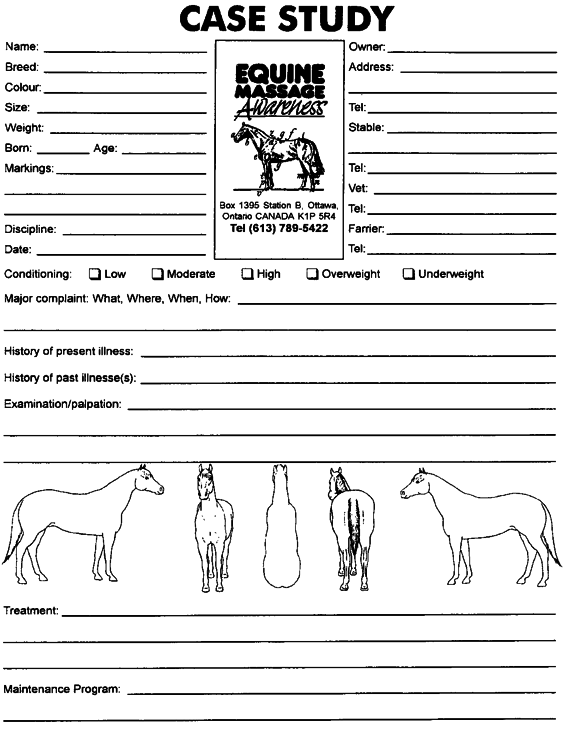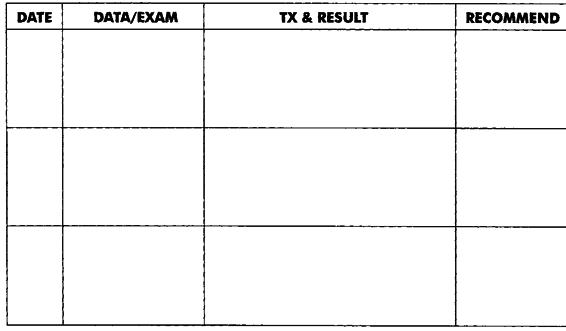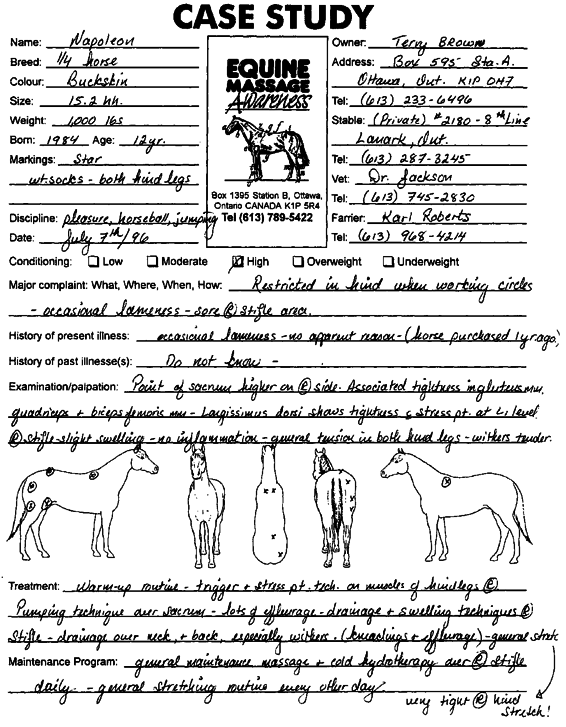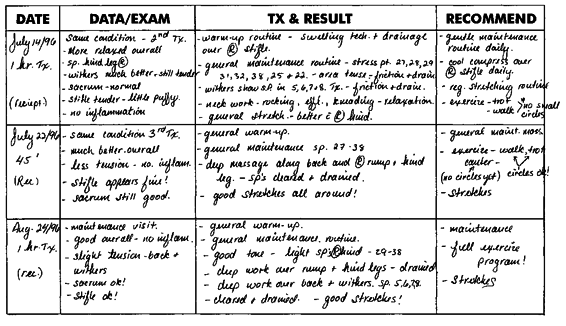Equine Massage: A Practical Guide (52 page)
Read Equine Massage: A Practical Guide Online
Authors: Jean-Pierre Hourdebaigt

You will never look at or touch your horse the same way again.
Enjoy your new awareness!
Basic Information About the
Horse
In this section of the case history you record:
❖ The horse’s name, breed, pedigree, color, size, weight, age (with date of birth, if known), any acquired scars or con-genital markings, conditioning (low, moderate, high), whether the horse is overweight or underweight and, if applicable, the type of work the animal does and has done.
Take note of the general health condition (and any signs of disease) of the coat, skin, eyes, pulse, temperature, and respiration; and finally, note the actions, personality, and overall appearance of the horse.
❖ The owner’s name, address, and telephone number; name and phone number of the establishment where the animal is boarded; the veterinarian in charge; the trainer; and the farrier. Record the name, address, and phone number of any applicable medical insurance company; keep track of all additional relevant information on a separate sheet.
The Major Complaint
For this section of the case history you want to find out and record as much information as you can regarding the problem you have been solicited to address.The following question outline will help you in this matter:
318
Equine Massage
What:
What happened to cause this problem or lameness? What kind of pain or lameness (sharp, dull, or excruciating; constant or intermittent)? Has it changed at all in quality or intensity since the onset? Was the onset gradual or sudden (what was happening before and during the initial signs)? What aggravates the pain?
What relieves it? Is it any better or worse in the morning or the evening? How do the symptoms affect the horse in daily life (work, rest, play, etc.)? Is there anything that is difficult or impos-sible for the horse to do since the onset of the problem?
It is very important to record notes in the owner’s own words.
Avoid too many direct or specific questions at first, but after the initial conversation, ask away. Recording the signs and symptoms will help you determine if the situation is treatable by massage technique or not.
When:
How long ago did it happen? Find out whether the problem is in an acute stage (first 24 hours), a subacute stage (24 to 72
hours), or a chronic stage (after 3 days).
Where:
What body parts are affected directly and indirectly by referral pain? (Example: Inflammation of the withers with referred pain along the back muscles and compensatory tightness in the neck and shoulder muscles.) Are there other symptoms associated with the problem, such as weakness, loss of appetite, sweating, abnormal swellings, or fever?
How:
How did it happen? In what way? Was an injury or unusual activity involved? Was there a trauma (such as a kick) or did it result from an old injury? Are there any lesions? Has there been too much exercise or a too-heavy workload on the muscle structures? Is there bacterial infection? In some cases, it may be impos-sible to get any information on how the problem occurred; you’ll hear, “He came from the field like this.”
The History of the Present
Illness or Problem
For this section, find out whether the problem has a known history. Have these symptoms occurred previously? Take notes of all details regarding the what, when, where, and how. Discover when the injury or symptoms first occurred and what type of therapy and veterinary work was done at that time.
Keeping Records
319
Find out whether or not there have been changes in the horse’s routine: feed change, moving stables or barns, different farrier, shoeing changes, or changes in training.
The History of Past
Illnesses or Problems
For this section you want to find out:
❖ The horse’s general health
❖ What other injuries have happened to the animal during the course of his life. Record what, when, where, how.
❖ Whether the actual problem might be secondary to a previous problem
Do not forget to consider that some problems might be of genetic origin. For example, a bone deformity (scoliosis, lordosis) can cause chronic muscle tension.
Clinical Examination
Palpate and evaluate the overall structures of the body, going over all muscle groups and joints in order to determine the quality and present state of the physiology of the animal. In chapters 9 and 10, you learned how to do a primary assessment in great detail. This is where you use that knowledge to size up the animal as you go along and to modify the assessment process to suit the occasion.
Remember the four T’s (tension, texture, tenderness, and temperature; chapter 3).
Also check the horse’s conditioning (low, moderate, high), whether he is overweight or underweight, and the condition of his coat, skin, and eyes.Take the pulse and temperature. Check the depth and frequency of respiration. Make a good overall appreciation of the animal.
All this will help you verify your notes and detect problems that may not be obvious at first.
Have the horse exercise in front of you to assess his actions and gait, first at a walk and then at a trot. This activity will help you determine the depth of discomfort and whether the problem is muscular or structural. After the muscles of the horse are warm, include stretching moves to check the range of motion of each limb, the neck, and the back.
320
Equine Massage
Use your stress point check-up routine to assess possible stress point buildup in response to the problem, or to evaluate the level of training when dealing with an athletic horse (chapter 5).
At this point of your case history you should know if there are any contraindications that may apply (chapter 2) and whether you can treat this particular problem or not.
Treatment
Now you can decide on the course of your first treatment. Take notes on what you do:
❖ The type of hydrotherapy used when applicable (see chapter 4)
❖ The type of massage routines or techniques used (see chapters 5 and 6)
❖ The type of stretching exercises, if applicable (see chapter 8) Record the horse’s feedback signs during the treatment, the change or relief of the signs and symptoms (if any), and any other relevant information.
Program
For this section, you estimate how many sessions it will take for a full recovery. At the same time, determine the time frame of the applications; for example, the treatment of chronic tension should require a 45-minute massage session plus 15 minutes of hydrotherapy (one half before and one half after massage) once a day, every day for 5 days.
Specify the type of massage technique to apply or routine to follow. Give such details as the pressure to use, the type and frequency of hydrotherapy to apply, and the type of stretching exercises. The more information you offer, the better the chances of success.
Maintenance
For this section, you determine the maintenance program in conjunction with the recovery process. For example, it might require light exercising such as walking or longeing, circles, figure eights, sand pit work, and so on.
Keeping Records
321
Updates
Systematically update your case history by recording the details of each treatment you give to the horse. Note the evolution of the condition, what you did during each treatment, the reaction of the animal, and your prognosis for further treatments and recommended exercises.
A good case history is the foundation of both assessment and treatment.Accurate notes will give you the facts you need to work with.
A case history will serve as a guide for further therapy and also as
a record which may be of use in the future.
Once you are comfortable with learning how to recognize and
describe abnormalities, the time to perform the complete examination and the taking of notes will be greatly reduced.
Maintaining good clinical records of treatment will make it possible for you to accurately discuss problems with veterinarians or
other equine therapists. Always consider the recommendations of
the veterinarian when determining the course of treatment.
A good case history will show your professionalism and will greatly
contribute to your success.


322
Equine Massage
16.1 Case Study


Keeping Records
323
16.2 Example of Filled-out Case Study
INDEX
Abdomen, 59–60
Blood pressure, positive effect, 59
Abduction, 153, 156–157, 161
Body language, 40, 45–47
Active trigger point, 104–105
Body language (yours), 46
Acute injury stage, 88
Body temperature, 13, 47
Acute rheumatism, 47
Bonding, 2, 40–41
Acute trauma, 47
Bones, 18–19
Adduction, 153, 157–158, 162
Boots, safety considerations, 50
Adjust (facial) nerve, 263
Bowed hocks, 193
Agonist, 153
Brushing, lameness indicator, 195
Agonist muscles, 163
Bursae (sheaths), tendons, 26
Anatomy
cardiovascular system, 11–13
Calcification, contraindication, 47
circulatory system, 11–15
Cancer, 47
digestive system, 15
Cannon bones, conformation, 190
endocrine system, 15
Capillaries, 12
lymphatic system, 11, 13–15
Capped hock, 192
muscular system, 23–39
Capsular ligament.
See
joint capsule
nervous system, 7–10
Carbon dioxide, positive effect, 59
points of the horse, 8–9
Cardiac muscles, muscle class, 23
reproductive system, 15, 18
Cardiovascular system, 11–13
respiratory system, 10–11
Carotid artery, 264
skeletal system, 16–23
Case history, 316–323
urinary system, 15
Caudal deep pectoral muscle, 212
Andalusians, 309
Caudal superficial pectoral
